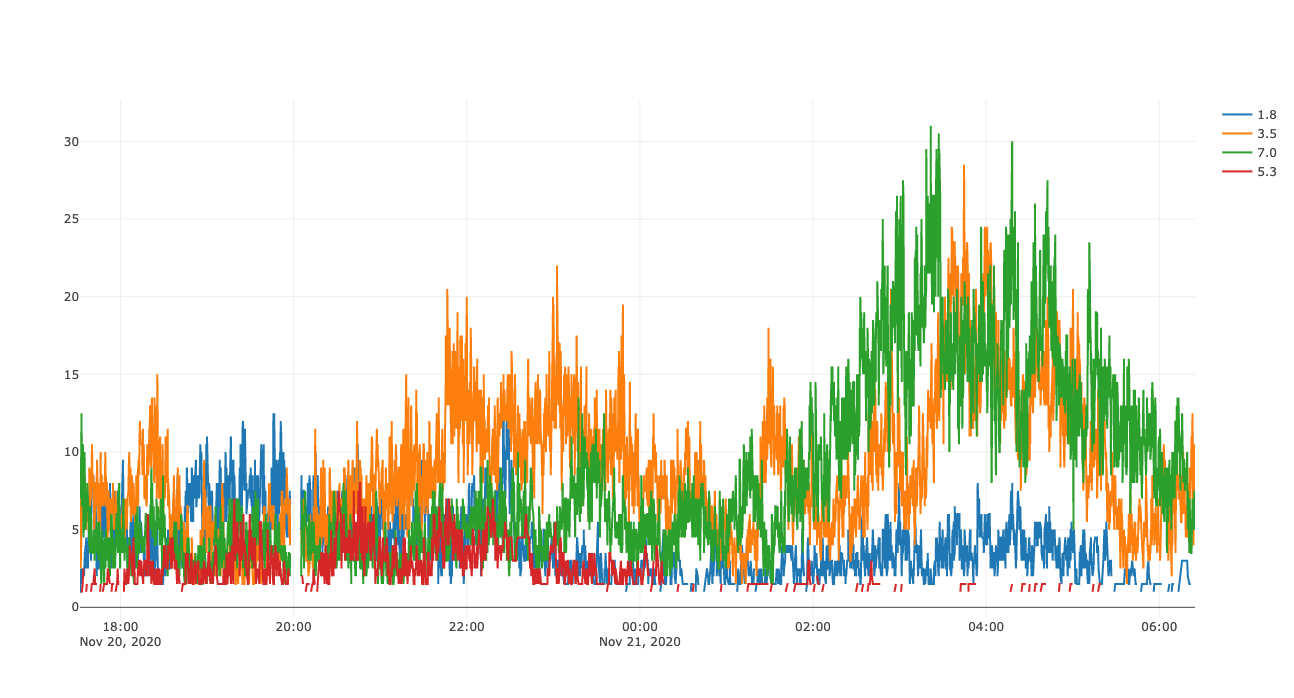When I tried to explain an FT8 exchange to colleagues I got the idea that I should unravel some as I hear them and make a web page of them. I got the unraveling done that evening. Here I take a first look the next morning.
See Spark Decodes for other experiments.
The bands were pretty quiet until 40 meters picked up after midnight. expand ![]()

The script reported call signs in alphabetical order, the number of exchanges heard and the information passed on the last transmission. I list these prefixed by the number of minutes elapsed since this last entry.
572.0 F4FCE - N5AO x1 RR73 571.7 W4ABF - WB4JTT x2 73 571.7 N6AKO - W7BOB x1 73 571.7 KB7JJG - KC2LST x1 73 571.7 N6HDV - N8BV x1 DM12 571.5 F4HJO - K0JY x1 DM68 571.5 KM6LBW - N5AO x1 -11 571.5 KA0JZX - XE1KK x1 RR73 571.5 MU0MXF - NR1DX x1 73 571.2 IZ3XJM - KE3QZ x2 RR73 571.2 KY0R - N7UR x2 DM78 571.0 WB6JJJ - XE2JS x2 73 571.0 AA4DD - EA6ET x1 EM86
Still unsure what further display would be useful I thought I should take a look at the data. I patched in a downloader to dump the exchange history which maps a callsign pair to an array of spots, first overnight and again the following morning. json ![]() json
json ![]()
Here is a typical entry where I heard one side of the tail end of an exchange.
"HP2AT - NN5O": [ { "time": "2020-11-21T06:03:15Z", "frequency": 5357633, "snr": -9, "dt": 0.2, "msg": "HP2AT NN5O +00", "distance": null, "call": "NN5O", "locator": null }, { "time": "2020-11-21T06:03:45Z", "frequency": 5357633, "snr": -8, "dt": 0.2, "msg": "HP2AT NN5O RR73", "distance": null, "call": "NN5O", "locator": null } ]
morning['AA0BQ - N0VTY'].map(spot=>spot.msg)
CQ N0VTY EN40 N0VTY AA0BQ EN35 AA0BQ N0VTY +01 N0VTY AA0BQ R-09 N0VTY AA0BQ 73
I feed these files into jq, the command line json inspector, and write unix pipeline queries.
I wonder, which CQ got the most responses? Here are the top 10 heard overnight.
jq '.[][0].msg' | \ grep '"CQ '| sort | uniq -c | sort -nr | head -10 42 "CQ K0TPP EM48" 42 "CQ HL5FUA PM57" 36 "CQ AA2MF EL87" 29 "CQ NA RM0F QN16" 29 "CQ KI0E DN13" 22 "CQ DX JF8QNF QN02" 19 "CQ AE7RN DN45" 18 "CQ DX N4QWZ EM66" 18 "CQ AG5XI EL09" 17 "CQ NF5KF EL96"
And again for the upper bands in the morning.
39 "CQ YO3FRI KN34" 32 "CQ ZS6LKF KG44" 30 "CQ PY2YW GG66" 29 "CQ ZS4JAN KG30" 26 "CQ 9G5FI IJ95" 25 "CQ KA2DUT FN30" 24 "CQ TG9SRP EK44" 24 "CQ K0HMZ DN88" 23 "CQ POTA KI4LLA FM07" 21 "CQ SM2LIY KP04"
I see KI4LLA working POTA stations. I learn from google that POTA stands for 'Parks on the Air'. site ![]()
38.1056, -79.6509
I continue developing for both a table in a full web page and for interactive wiki pages in the lineup. github ![]()
A day passes coding late morning and again in the evening. See Making the Exchange Script